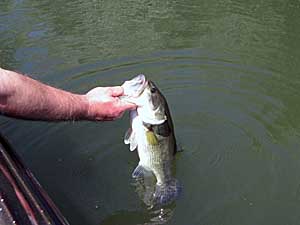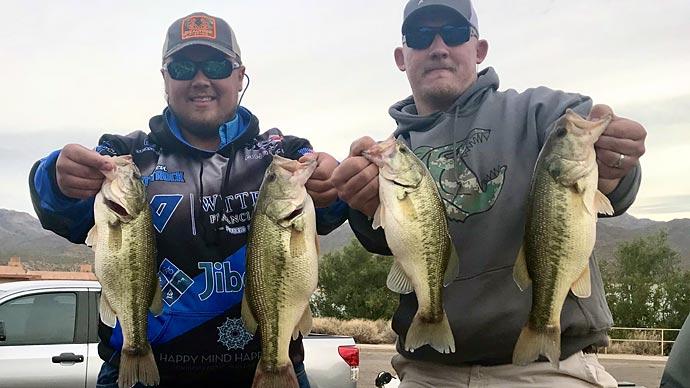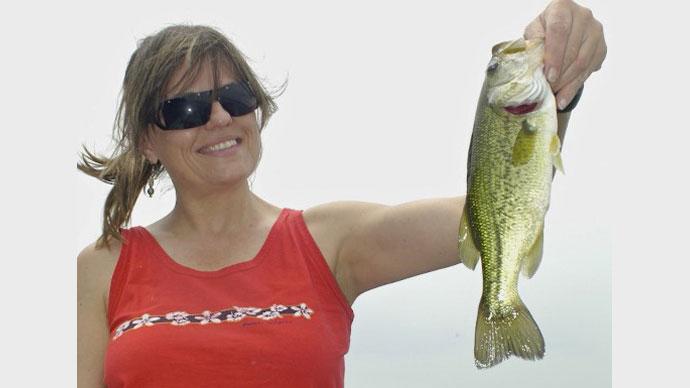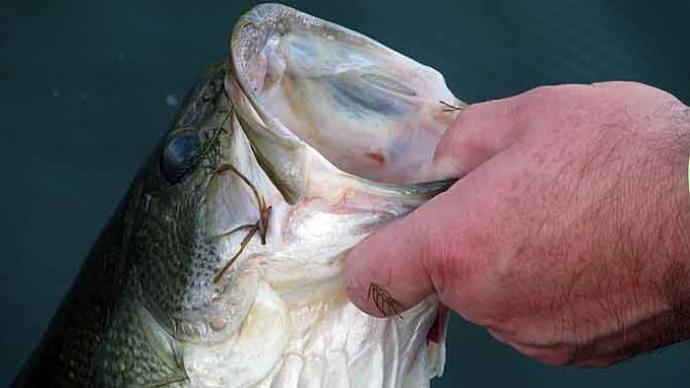
First, some history. I am not a foreigner. I grew up in the bass capital of the world; Odessa, Texas. Those of you that have fished these waters... well, you know what I mean. The closest sizable lake is about 90 miles away, and on most weekends there is a large pilgrimage of west Texans leaving to chase bass all around the state. Because my father took the time to get us out of town and on the water, I fished frequently in west Texas and had good fishing on Oak Creek, Twin Buttes, and Lake Nasworthy. The fish weren't really big, but I lived for fishing and enjoyed chasing bass on these waters.
During the 1970's, I remember dreaming to catch a 5-pound bass, and many anglers in those days would proudly mount these fish as a trophy. However, there was a transformation in Texas during the 1980's. Size limits, Florida bass stocking, and the recent construction of new reservoirs contributed to vastly improve Texas' bass fisheries. By the time I went to college at Texas A&M in the late 1980's, Texas lakes were established as some of the finest trophy bass waters in the country. I had the pleasure of fishing at lakes like Fayette County, Gibbons Creek, and Houston County. Fishing on these lakes was better than any I had experienced in west Texas. I, like many anglers, believed that the quality fishing in Texas was due mostly to the aggressive use of size limits to protect fish from harvest. Since that time I have moved across the southeast and remain an avid bass angler. I still believe that size limits have greatly improved many bass populations, but through time my perspectives have changed to believe that anglers should also use selective harvest, that is keep some bass in some situations.
What happened in the 1990's and where are we now? Largemouth bass size limits that were so common in Texas spread throughout the southeast during the 1990's, and now most states have specialized regulations on at least a portion of their fisheries. Many states still have fairly liberal statewide bass size limits such as a 12-inch minimum length limit, but more-stringent regulations have become an important part of managing bass fisheries in most areas. Fisheries biologists across the country work to implement restrictive size limits on lakes where success is likely.
So what factors determine the success of a regulation? The three components that are critical are G, R, and M of the bass population (Growth, Recruitment and Mortality). G, R, and M are measured by fisheries biologists and usually determine the success or failure of a length limit on any given lake. So let's talk in more detail about G, R, and M and describe how they affect a bass fishery.
Growth rate is defined as how long it takes for a fish to reach a given size. In some lakes, bass may attain 3 pounds in less than 3 years, which is considered rapid growth. Exceptional growth rates on some new Texas reservoirs were measured at about 2 pounds/year, which will produce some 10-pound fish in only 5 years! Regulations on lakes with rapid growth will allow fish to quickly grow to a size preferred by anglers without the threat of harvest. Alternately, slow growing bass may not attain 3 pounds until age 5 or 6. Stringent regulations on a slow-growing population may do more harm than good. Why? Forage fish availability largely governs the growth rate of bass and slow growing populations result from insufficient food or too many fish competing for a limited amount of food. So, restricting the harvest of bass from a slow growing population may make matters worse by further reducing growth rates due to low food availability per individual. Extreme cases of slow growth often occur in farm ponds where bass may nearly cease growing, resulting in very few large fish and many 10-12 inch fish. Ponds with very slow growth would benefit from harvest by reducing bass abundance, increasing the amount of food available per fish, which would improve growth rates. Slow growth also occurs in larger lakes and reservoirs, and regulations on these populations may be detrimental to the production of large fish.
Mortality represents the percent of fish that die each year. Fisheries biologists usually divide total mortality into fishing mortality (the percent that die from harvest and hooking mortality) and natural mortality (the percent that die due to causes other than fishing). Size limits are effective at reducing fishing mortality on lakes where fish are being harvested and catch and release is not commonly practiced. If growth rate of adult fish is adequate, size limits will improve the number of large fish in lakes with high fishing mortality. However, in lakes where fishing mortality is low due to low fishing effort or high rates of catch-and-release, size limits will usually not improve the number of large fish in the population.
Recruitment is the number of young fish that survive to adulthood (usually one year old) each year. Recruitment also varies widely from lake to lake and across years in the same lake. Lakes with 20 to 40% coverage of aquatic plants usually have high bass recruitment, whereas lakes with little shoreline cover often have low to intermediate recruitment. Lakes with high recruitment are often the best fisheries if growth rates are rapid and mortality rates are relatively low. This causes many fish to survive to a preferred size by anglers. However, high recruitment can be detrimental if growth rates are slow due to the addition of many more hungry mouths to feed! Populations with moderate to fast growth rates and high recruitment are often managed with slot limits, with the hope that anglers will remove small fish and sustain adequate growth of fish in the slot. Lakes with low recruitment are often managed with minimum-size limits in order to protect adult fish and maximize production of young bass.
Recruitment can fluctuate substantially on a given lake from year to year. Reductions in water levels often reduces the amount of cover for young fish and may result in poor survival, whereas periods of high water may inundate shoreline cover and produce very strong year classes. Many of these fluctuations are out of the fishery biologists' control but will strongly affect the number of adult fish that are present in the population for several years. Anglers are familiar with this type of cycle, where low water levels often cause poor fishing over 3 to 5 years, but when the lakes fill it is almost like a new impoundment, with the flooded salt cedar and cottonwood trees. This causes tremendous production of young fish and quality fishing for 3 to 5 years. Many other lakes undergo a similar scenario, where recruitment fluctuates across years due to changing environmental conditions. Recruitment fluctuations may cause the abundance of adult fish to vary from year to year, and the fishing quality also varies accordingly regardless of the size limit.
From the above discussion, it is clear that Growth, Mortality, and Recruitment will interact to determine the success of a regulation. Bass populations with fast growth, low mortality, and high recruitment will produce outstanding catches of both quality and trophy-sized fish. Honey Hole Magazine provides detailed reports on about 20 to 25 Texas lakes in every issue. These lakes are the premier bass fisheries in Texas, and I suspect that most of them would fall into this category of rapid growth, low mortality, intermediate to high recruitment, or at least two of these three qualities. Lakes that are not commonly associated with trophy fish or have low catch rates of quality fish may suffer from slow growth, high mortality, low recruitment, or a combination of these factors. You can probably think of some of these as well.
The transformation of anglers to a catch-and-release mentality has been remarkable. In a period of about 15 years, bass anglers have changed from harvesting most legal fish to almost entirely catch-and-release angling. Most recent creel survey data has shown that over 90% of bass caught are released, even when the fish were legal to keep. Anglers have had a strong influence on the conservation of our fishery resources and have improved the abundance of preferred-size fish in many systems through catch-and-release.
However, I have found that most anglers believe that strict catch-and-release will always improve bass populations. I used to be in the same group, but my perspectives have changed. Regulations should be tailored to the existing G, M, and R for each population. Just as importantly, angler harvest rates should also change depending on G, M, and R for each population! Some lakes will benefit from complete catch and release, but lakes with slow growth and abundant small fish would benefit from selective harvest to reduce the number of small fish and improve growth rates.
I believe that Texas Parks and Wildlife has done an outstanding job of using lake-specific regulations to improve many fisheries. Slot limits are used to encourage harvest of small fish, improve growth rates, and protect the large fish in a lake. However, complete catch-and-release by anglers on lakes with a slot limit may result in too many small fish and reduced growth rates. This can be particularly detrimental to producing trophy fish. In order for fish to reach 10 pounds, they must grow rapidly throughout their lives and cannot withstand 1 or 2 years of slow growth. Thus, selective harvest of smaller fish can actually help some fisheries by increasing the available food per-individual, improving growth rates, yet protecting large fish from harvest to allow them to reach trophy size. For lakes with slow growth, the only practical tool for reducing the abundance of small fish and improving growth rates is angler harvest. This is a tool that has declined in effectiveness due to a strict catch-and-release ethic among bass anglers.
Fishery managers may sometimes suggest changes in a regulation to improve growth rates. For example, a 14- to 21-inch slot is essentially a 21-inch minimum length limit if anglers keep very few fish below the slot. This may result in a stockpiling of fish in the slot and moderate growth, potentially causing few fish to grow and survive to surpass 21 inches. In these cases, the best management scenario may be to change the regulation and allow harvest of some fish that are in the slot. As an example, the slot limit could be changed from 14 to 21 inches to 18 to 22 inches, thus allowing anglers to keep some fish below 18 inches and hopefully improve growth rates. However, a change in the regulation will not improve growth rates if anglers release all of their fish!
Reservoirs, like fish, have a life span and a peak in production. Most reservoirs peak in production of largemouth bass somewhere between ages 5 and 12 years old. After reservoirs reach about 15 years old, they usually do not sustain the fish growth rates found during early years, resulting in fewer trophy fish. Older reservoirs lose quality habitat such as timber and shoreline vegetation, and this loss in habitat can result in lower recruitment or growth rates. Presence of aquatic plants will maintain quality habitat in older reservoirs and sustain high recruitment due to good survival and production of young fish.
Nevertheless, older reservoirs still do not typically produce the exceptional growth rates and abundance of large fish as was present when the reservoir was young. The use of some angler harvest to improve growth rates may be most important in older reservoirs where growth rates have declined.
Catch-and-release has served anglers well and will continue to do so in the future. However, bass anglers should be willing to use selective harvest as a tool to improve some fisheries. How do you know what lakes need some harvest and what size of fish should be kept?
Lakes with a slot limit will likely benefit from harvest of fish below the slot. Slot limits were chosen by fishery managers because these lakes usually have high bass recruitment with moderate to fast growth rates. Local tournaments on these lakes could keep undersized fish, and after a few tournaments there would probably be enough for a fish fry at the end of the year. It is not a sin to eat a bass, just don't eat the big ones! If the lake you fish does not have a slot limit but provides high catches of small fish and very few large fish, it may help if anglers keep small fish to eat but release the bigger ones. I suggest contacting the district fisheries biologist in your region to get their recommendation on the optimal harvest strategy for specific lakes.
Bass anglers have mastered catch-and-release, but we should move into a new era of selective harvest for better management.



